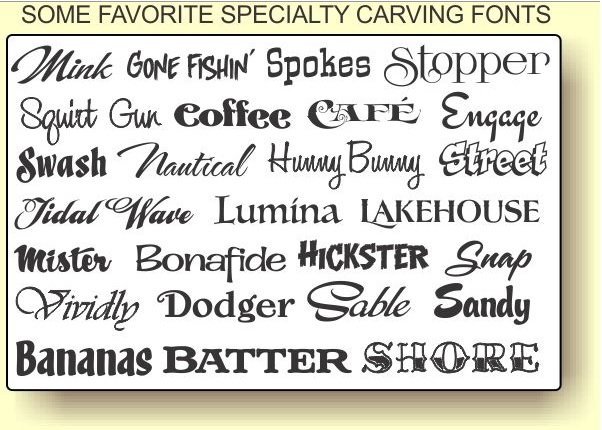All Guides - Start Here
Beginning
Setting Up Guide
Marketing Guide
Tools
Tool Guide
Tools
Wood
Wood Guide
Carving Guide
Finishing Guide
Sign Designs
Sign Shapes
Shape Dimensions
Methods
Background Guide
Design Guide
Layout Guide
Shipping Guide
|
Practice These
Proper hand positions; Fingers on the handles and on the board guiding the cut.
Circles:
- O, Q, P, R, D etc.
- Feel the grain on the circle
- Stay away from the lines and edges on the first pass
Straight lines:
- A, E, I, T, F, H
- Do not stop. Lift out for small letters and end details
Angles:
Further Practices
- Carving Liner bit doing fine lines
- Backgrounds: 60, 90, power carving, dimples, big circles 3/4 - 90, small circles 1/2 - 90
- Stipple effect 45 - 45
- Edges, profiles, aged (rope border), comic, scallops (deep enough)
- Sign shapes
- Straight lines, curves, circles
Also play with colors, dyes, pints, inks
Organize
- Pattern folders / cardboard holder sprayed with the pattern
- Pictures fit into a sheep protector
- Font print sheets fit into sheet protectors and a binder
Routing long, straight, boxes and around edges:
- Select the bit depth
- Sink the bit into each corner or each end
- Turn the router off
If the router is turning do not set it upside down; it sucks up sawdust
- Set the bit into one hole and turn the curved edge of the base plate out
- Move a straight edge up to the curved edge of the base plate and clamp the straight edge
The curved edge of the base plate riding on the straight edge offers less resistance
- Place the router bit in the other hole and place the straight edge up against the base plate
- Rout between the holes
|
Palm vs Full Size
Worn bearings are not for fine detail work; shaft has runout and is floating. Patterns and fine detail work need top quality bearings
- Larger routers are great for cleanouts with flat bits.
- Use the bigger routers for larger 1/4 and all 1/2 in shank bits
- Standard backgrounds use 90 Deg. for cleanout. 90 is also used for outset and very large inset letter cleanouts.
- Work from the center out to support 1/2 of the base resting on a flat surface
- Chuck the bit at about 1/2" to keep the motor away from the base.
- Keep Bits Clean. Gunk spray or oven cleanre removes resins and pitch
- Use a dremmel brass brush - chuck bit in the router (unplugged) to hold it still
Techniques
- When plugging in always assume the switch is ON
- High Torque warning: Some routers have quite a jerk on startup
- 'Soft Start' routers are the new norm. Be aware of older model hard starts
- When turning ON ground the router to the board or your arms to the bench
- All routers: Ground the router to the table when turning OFF
- Do not set the router top on the table while it is still turning. It will suck dust into the motor
- Work toward you
- 2 hands on the handles AND fingers on the workpiece
- Resin bubbles? Simply blow on it or use a heat gun on low to spread colors and remove bubbles.
|
Glue-Ups
- Gorilla glue, Titebond = outdoor projects
- Pine panel boards use the same process BUT watch cupping on new stock. They may crack under clamps
- When laminating backing - brad the corners to keep the laminations together and corners square
- Run through the table saw or planer to get one edge 90 deg.
- Flip the board and run through for the width of boards
- Set up work area and clamps
- Use wax paper, tape on to protect clamps from glue etc.
- Lay out on top of the clamps and mark orientation on ends
- Draw index marks several places
- Stand boards one at a time on edge and apply glue
- Make sure edges and entire length is covered well
- Clamp one side and draw up snug, not tight
- Clamp other side that is farthest away from the first clamp just snug
- Clamp in the middle between the end clamps
- Lay a caul (piece of wood) across the entire width and clamp with a block under the glued up pieces
- Tighten clamps one by one, tightening the caul last
- Clamp ends to prevent cupping
- wipe off excess glue
|

